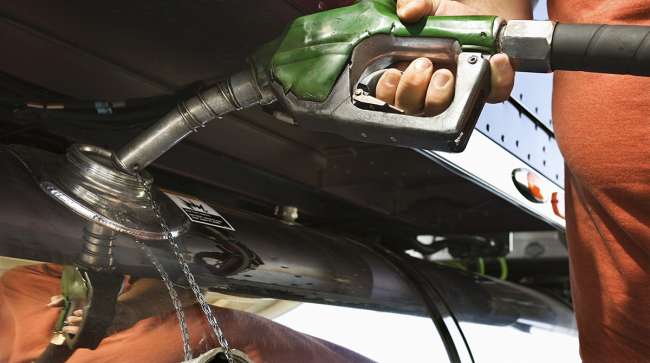Senior Reporter
Diesel Climbs 0.2¢ to $3.171

The U.S. average retail price of diesel climbed 0.2 cent to $3.171 a gallon, as crude oil prices settled below $63 amid international tensions, the Department of Energy reported May 6.
Diesel now costs exactly the same as it did a year ago, DOE said.
With only two exceptions, the U.S. average retail diesel price has climbed each week since Feb. 11.
Regional diesel prices were mixed, lower in five regions and higher in five.
U.S. average #diesel fuel price on 5/06/2019 was $3.171/gal, UP 0.2¢/gallon from 4/29/19, same price as year ago https://t.co/UVCrBzltdc #truckers #shippers #fuelprices pic.twitter.com/NV1bnVhp74 — EIA (@EIAgov) May 7, 2019
Also last week, the national average price for regular gasoline climbed 1 cent to $2.897 a gallon, DOE’s Energy Information Administration said.
The national average is 5.2 cents more than a year ago, EIA said.
Regional average gasoline prices were also mixed, falling in two areas and climbing in seven.
EIA suggested gasoline prices will go higher.
For the 2019 summer driving season, which runs from April through September, EIA forecasts that U.S. regular gasoline retail prices will average $2.92 per gallon, up from an average of $2.85 a gallon last summer. The higher prices primarily reflect EIA’s expectation of higher gasoline refining margins this summer, despite slightly lower crude oil prices.
A truck maker executive said emissions regulations were catalysts for greater fuel efficiency in heavy-duty trucks.
“With all the improvements in greenhouse gas emissions, our customers keep seeing that the trucks we’re building today deliver up to 15% better fuel economy than the trucks they booked four years ago, and that really helps them when they have to decide on replacing their equipment,” Paccar Inc. Executive Vice President Preston Feight said during a first-quarter earnings call.
Feight is scheduled to become Paccar’s CEO on July 1. The company’s truck brands include Kenworth Truck Co. and Peterbilt Motors Co.

A. Duie Pyle truck by raymondclarkeimages/Flickr.
One fleet is beginning to operate electrified trucks in pickup-and-delivery operations, but sees an ongoing future with diesel engines, too.
“We burn about 1 million gallons of diesel a month across the enterprise,” A. Duie Pyle Inc. COO John Luciani told Transport Topics. “We expect that there will be continued advances in diesel exhaust aftertreatment to help diesel to burn cleaner.”
A. Duie Pyle Inc. ranks No. 79 on the Transport Topics Top 100 list of the largest for-hire carriers in North America.
Pyle operates 1,230 power units in Classes 5-8.
Meanwhile, diesel particulate matter, as a toxic air contaminant, poses especially serious health risks, according to the California Air Resources Board.
Installation of diesel particulate filters to control PM often raises concerns about increased exhaust backpressure, which decreases the fuel efficiency of a truck’s engine, according to experts.
CARB recently released an assessment of the technical feasibility of lower oxides of nitrogen standards and associated test procedures. In it, the agency noted some engine manufacturers are selecting more porous diesel particulate filters to reduce engine backpressure at the expense of higher PM emissions rates, “albeit still compliant with the current PM standard.”
In related news, growth in biodiesel production has coincided with federal biofuel mandates and other conditions that encouraged a larger share of the domestic soybean oil supply to be consumed as biofuel feedstock, EIA reported. Three-fourths of total biodiesel feedstock in the United States is made from vegetable oils, with soybean oil accounting for slightly more than half of total inputs by weight.
Biodiesel is a mixture of chemical compounds known as alkyl esters produced from vegetable oils, fats and greases. Domestic production of biodiesel grew to 1.8 billion gallons in marketing year 2018 compared with 700 million in marketing year 2011. Soybean oil and other vegetable oils also may be used as a feedstock for renewable diesel, a separate biofuel that is increasingly produced at stand-alone facilities and petroleum refineries, EIA reported.
On Nov. 30, the U.S. Environmental Protection Agency’s Renewable Fuel Standard raised volume requirements for biomass-based diesel — which collectively refers to biodiesel and renewable diesel — to 2.43 billion gallons for 2020 compared with 2.1 billion in 2019.
The United States has been losing, for many years, 600 to 800 Billion Dollars a year on Trade. With China we lose 500 Billion Dollars. Sorry, we’re not going to be doing that anymore! — Donald J. Trump (@realDonaldTrump) May 6, 2019
At the same time, the crude market was roiled by President Donald Trump’s tweets threatening more tariffs on Chinese goods and reports of a U.S. naval task force heading to the Middle East as a warning to Iran.
EIA in its short-term energy outlook for May is forecasting increasing global disruptions in 2019 to crude oil production.
West Texas Intermediate crude futures on the New York Mercantile Exchange closed at $62.25 per barrel May 6, compared with $63.50 on April 29.
May 6 oil prices hit a low of $60.04 a barrel.




